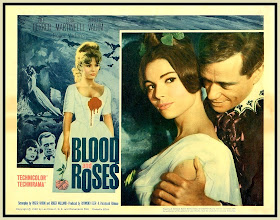Annette Vadim
(Carmilla Von Karnstein), Mel Ferrer (Count Leopoldo Von Karnstein),
Elsa Martinelli (Georgia Monteverdi), Serge Marquand (Giuseppe),
Jacques-Rene Chauffard (Dr Verari)
PRODUCTION:
Director –
Roger Vadim, Screenplay – Roger Vadim & Roger Vailland, Story –
Claude Brule & Claude Martin, English Language Version Written by
Peter Viertel, Based on the Short Story Carmilla by J. Sheridan
Le Fanu, Producer – Raymond Eger, Photography – Claude Renoir, Music –
Jean Prodromides, Art Direction – Jean Andre & Robert Guisgand.
Production Company – Les Films EGE/Documento Films.
SYNOPSIS:
At the ancestral home of the Von Karnstein family in Rome, a masque is held to celebrate the latest descendant Count Leopoldo’s engagement. However, a fireworks display triggers off an unexploded WWII bomb, unearthing the tomb of the Von Karnstein’s vampire ancestor Mircalla. Mircalla emerges and now draws to her and possesses the mind of Leopoldo’s cousin Carmilla.
At the ancestral home of the Von Karnstein family in Rome, a masque is held to celebrate the latest descendant Count Leopoldo’s engagement. However, a fireworks display triggers off an unexploded WWII bomb, unearthing the tomb of the Von Karnstein’s vampire ancestor Mircalla. Mircalla emerges and now draws to her and possesses the mind of Leopoldo’s cousin Carmilla.
COMMENTARY
This was the second film made from J. Sheridan Le Fanu’s oft-filmed short story Carmilla (1872). (The first was claimedly Carl Dreyer’s Vampyr (1932), although the connection there is very slim). Blood and Roses
comes from Roger Vadim, the French director of various softcore
features in the 1960s such as the Brigitte Bardot breakthrough, And God Created Woman (1957) and the great softcore space opera Barbarella (1968).
Hammer Films had spurred off a substantial revival of Gothic horror with their twin successes The Curse of Frankenstein (1957) and Dracula/The Horror of Dracula (1958) and it seems almost certain that Blood and Roses was intended to ride that wave of success. Hammer Films themselves later spun off a series of Carmilla films, beginning with The Vampire Lovers
(1970), with which inevitable comparisons arise. (See below for the
Hammer films). The one thing that the Hammer comparison makes one
realise is how much Terence Fisher et al tied Hammer’s vision of the
Gothic to a specific period and time – when Blood and Roses
updates the Le Fanu story in a modern setting one has to consciously
jolt themselves to realise that the presence of planes, sports-cars and
stereos is not anachronistic.
Opposing the
rich, flamboyance of Hammer’s treatment, Roger Vadim’s vampirism is a
lot more soft-focus and softcore in intent. There is more eroticism than
horror to the film (and British censors cut out much of the softcore
lesbianism anyway). In fact, there is very little vampirism going on –
there is a ludicrously tame scene where Annette Vadim pursues a servant
girl that fades out just as Vadim closes in on her. Nor does the plot do
much with the possession/vampirism themes. The atmosphere Roger Vadim
creates is occasionally compulsive – there are undeniably striking
shots, like the lake lit up by fireworks, and, in particular, the
surrealistic fevre dream that turns black-and-white with bodies swimming
upside down outside French windows and an operation where the surgeon’s
gloves are all tinted blood red. The beautiful photography, classy
music, elaborate costumes and ornately layed-out gardens make for a
sumptuously assembled film – but alas little more than that.
Other adaptations of Carmilla include:– Terror in the Crypt (1963); Hammer’s trilogy consisting of The Vampire Lovers (1970), Lust for a Vampire (1971) and Twins of Evil (1972); The Blood-Spattered Bride (1972) and Carmilla (tv movie, 1987).








No comments:
Post a Comment
WE ENCOURAGE YOUR COMMENTS AND OPINIONS ABOUT OUR POSTS. FEEL FREE TO LEAVE A COMMENT.